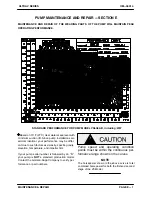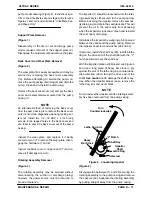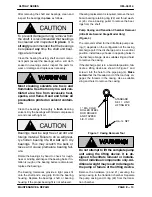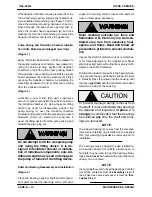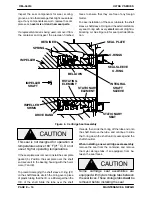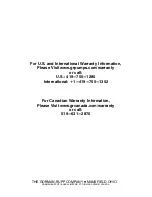
OM-06014
ULTRA V SERIES
MAINTENANCE & REPAIR
PAGE E - 15
Heat the bearings to a uniform temperature
no
higher than
250
F (120
C), and slide the bearings
onto the shaft, one at a time, until they are fully
seated. This should be done quickly, in one con
tinuous motion, to prevent the bearings from cool
ing and sticking on the shaft.
After the bearings have been installed and allowed
to cool, check to ensure that they have not moved
away from the shaft shoulders in shrinking. If
movement has occurred, use a suitably sized
sleeve and a press to reposition the bearings
against the shaft shoulders.
If heating the bearings is not practical, use a suit
ably sized sleeve, and an arbor (or hydraulic) press
to install the bearings on the shaft.
When installing the bearings onto the
shaft,
never
press or hit against the outer
race, balls, or ball cage. Press
only
on the
inner race.
Install the thrust washer (23) and secure the out
board bearing (24) to the shaft with the snap ring
(22).
It is recommended that a sleeve be positioned
against the inboard oil seal (6) to prevent the lip of
the oil seal from rolling as the shaft and bearing are
installed in the bearing housing. The O.D. of the
sleeve should be just smaller than the bearing
housing bore, while the I.D. of the sleeve should be
just larger than the O.D. of the lip seal area of the
shaft.
With the lip seal sleeve in place, lubricate the lip
seal area of the shaft, and slide the shaft and as
sembled bearings into the bearing housing until
the retaiining ring on the outboard bearing seats
against the bearing housing. Remove the lip seal
sleeve.
When installing the shaft and bearings into
the bearing bore, push against the outer
race.
Never
hit the balls or ball cage.
Position the outboard oil seal (6) in the bearing
housing bore with the lip positioned as shown in
Figure 4, Detail B. Press the oil seal into the hous
ing until the face is
just flush
with the machined
surface on the housing.
Press the oil seal (19) into the bearing cap (20) with
the lip positioned as shown in Figure 2, Detail C.
Replace the bearing cap gasket (21) and secure
the bearing cap with the hardware (17 and 18).
Be
careful
not to damage the oil seal lip on the shaft
keyway.
Lubricate the bearing housing as indicated in
LU
BRICATION
.
Seal Installation
(Figures 4 and 8)
Most cleaning solvents are toxic and
flammable. Use them only in a well ven
tilated area free from excessive heat,
sparks, and flame. Read and follow all
precautions printed on solvent contain
ers.
Clean the seal cavity and shaft with a cloth soaked
in fresh cleaning solvent. Inspect the stationary
seat bore in the seal plate for dirt, nicks and burrs,
and remove any that exist. The stationary seat bore
must
be completely clean before installing the
seal.
A new seal assembly should be installed
any time
the old seal is removed from the
pump. Wear patterns on the finished faces
cannot be realigned during reassembly.
Reusing an old seal could result in prema
ture failure.
The seal is not normally reused because wear pat
terns on the finished faces cannot be realigned
during reassembly. This could result in premature
failure. If necessary to reuse an old seal in an emer
gency,
carefully
wash all metallic parts in fresh
cleaning solvent and allow to dry thoroughly.

